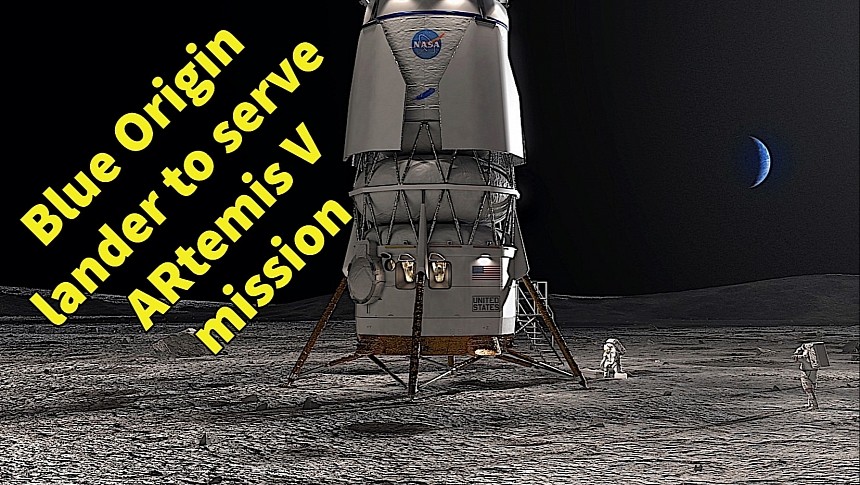As promised, on Friday, May 19, NASA came out with the name of the company making the lander for the crewed Artemis V mission to the Moon. Like many were expecting, the name of the winner is Blue Origin.
Most of you remember how we got here. A couple of years ago, when NASA selected Elon Musk's SpaceX as the maker of the lander for the Artemis III mission, Jeff Bezos, the man behind Blue Origin, threw everything at the decision, from legal challenges to promises of price cuts for NASA, in a bid to get his Blue Moon noticed and selected.
Bezos lost all those battles back then, but last week's announcement comes as a sort of retribution for him. But what exactly is Blue Origin expected to do?
As its name says, a lunar lander is supposed to land on the Moon, in this case carrying humans on board. It'll have to be launched from Earth, travel all the way to our planet's satellite, and wait there to transport human crews to the surface.
Just like the Artemis III Starship HLS, Blue Origin's solution will have to be able to land anywhere on the Moon's surface. It will also have to be able to dock with the Gateway space station expected to be built around the Moon. The lander is to be reusable, allowing for multiple trips to and from the Gateway, and it will be powered by a combination of liquid oxygen (LOX) and liquid hydrogen (LH2).
To help with the design, development and testing of the lander, NASA awarded Blue Origin a contract worth $3.4 billion. For that, the company promises not only to design this hardware, but also a cislunar transporter. Furthermore, a new way of storing LOX and LH2 will be developed in order to prevent the fuels tendency to boil off. Not many details on that were provided, except the fact the solution involves "solar-powered 20-degree Kelvin cryocoolers," among other things.
As per the timeline established by NASA, Blue Origin will have to fly its human-rated lander without humans on board first (just like SpaceX is expected to do), and then move on to the actual crewed mission. All of this should take place before 2029, when Artemis V is expected to depart.
Being the third crewed mission to the Moon might make Artemis V look a bit unimportant, but that's quite the opposite. NASA describes it as the tipping point from "demonstrating NASA’s initial lunar exploration capabilities" to supporting "recurring complex missions in lunar orbit and on the surface as part of the agency's Moon to Mars exploration approach."
Artemis V will have four astronauts fly to the Moon. Two of them will stay inside the gateway space station, while the other two will descend to the satellite's South Pole for a week-long mission.
Bezos lost all those battles back then, but last week's announcement comes as a sort of retribution for him. But what exactly is Blue Origin expected to do?
As its name says, a lunar lander is supposed to land on the Moon, in this case carrying humans on board. It'll have to be launched from Earth, travel all the way to our planet's satellite, and wait there to transport human crews to the surface.
Just like the Artemis III Starship HLS, Blue Origin's solution will have to be able to land anywhere on the Moon's surface. It will also have to be able to dock with the Gateway space station expected to be built around the Moon. The lander is to be reusable, allowing for multiple trips to and from the Gateway, and it will be powered by a combination of liquid oxygen (LOX) and liquid hydrogen (LH2).
To help with the design, development and testing of the lander, NASA awarded Blue Origin a contract worth $3.4 billion. For that, the company promises not only to design this hardware, but also a cislunar transporter. Furthermore, a new way of storing LOX and LH2 will be developed in order to prevent the fuels tendency to boil off. Not many details on that were provided, except the fact the solution involves "solar-powered 20-degree Kelvin cryocoolers," among other things.
As per the timeline established by NASA, Blue Origin will have to fly its human-rated lander without humans on board first (just like SpaceX is expected to do), and then move on to the actual crewed mission. All of this should take place before 2029, when Artemis V is expected to depart.
Being the third crewed mission to the Moon might make Artemis V look a bit unimportant, but that's quite the opposite. NASA describes it as the tipping point from "demonstrating NASA’s initial lunar exploration capabilities" to supporting "recurring complex missions in lunar orbit and on the surface as part of the agency's Moon to Mars exploration approach."
Artemis V will have four astronauts fly to the Moon. Two of them will stay inside the gateway space station, while the other two will descend to the satellite's South Pole for a week-long mission.












